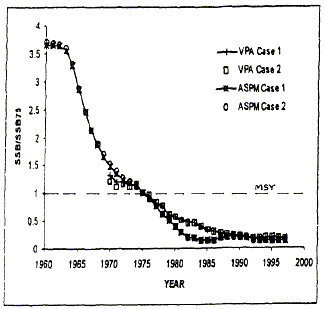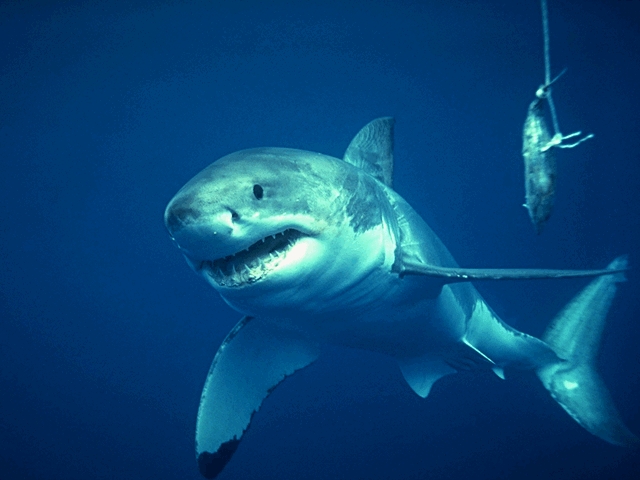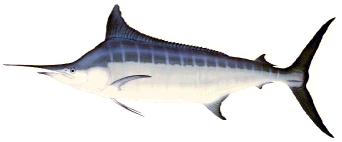 |
 |
 |
 |
 |
 |
 |
 |
 |
 |
 |
 |
 |
 |
 |
 |
 |
 |
 |
 |
 |
 |
 |
 |
 |
 |
 |
 |
 |
 |
 |
 |
 |
 |
 |
 |
 |
 |
 |
 |
 |
 |
 |
 |
 |
 |
 |
 |
 |
 |
 |
 |
 |
 |
 |
 |
 |
 |
 |
|
GOING, GOING, GONE!
Page 2 of 2
Go Back to Page 1
|
|
|
|
Go Back to Page 1 |
|
|
|
 |
|
|
Sailfish |
|
|
|
|
|
As shown in the figure on the left, in the 1960s the western Atlantic sailfish/spearfish stock's abundance or biomass was relatively healthy. (ICCAT lumps the rare spearfish with sailfish.) This combined stock's abundance was then estimated by ICCAT to have been well above the MSY level (1.2 to 1.5 times MSY). But by 1991, this stock had been driven to about 60 percent of its MSY biomass level (the horizontal dotted line at 1.0). Since 1984, fishing pressure (indicated in the figure to the right) has remained well above that level that would produce the MSY, ranging from 1.3 to 2.1 times the level this stock could tolerate on a sustainable basis. However, we simply have no information on the stock's abundance or fishing pressure on it since 1991. Longlines are believed responsible for 98 percent of the kill caused by U.S. vessels, with anglers responsible for the remainder. |
|
|
|
|
|
|
 |
|
|
|
Bluefin Tuna |
|
|
 |
|
|
With the exception of white marlin, the big game species in the greatest danger of slipping into extinction is the western Atlantic bluefin tuna. Since 1960, its abundance has declined by 95 percent. It was then at a healthy population level - about 3.7 times the MSY level. (For the 23 years prior to 1998, ICCAT had considered the biomass that existed in the mid-1970s as the MSY level for this stock.) According to NMFS, at the end of 1995, the stock's biomass was estimated to have declined to between 6 and 12 percent of that needed to produce the MSY. The spawning stock biomass (fish age 8 and above weighing at least 320 pounds) had then declined to 14 to 17 percent of its 1975 level. Thus, since 1960 the population has been driven from a healthy level to a level just above extinction by unrestrained industrial-scale commercial fishing sanctioned by ICCAT on this, the world's most valuable fish. The population is being held at this precarious level by continued fishing allowed by ICCAT, ostensibly to provide scientific monitoring information. In reality, it is unnecessary to kill any remaining bluefin until they can recover, since the abundance of each year class could be assessed using non-lethal means such as aircraft and tagging. But, this would eliminate the huge profits being made by some individuals with considerable political influence. |
|
|
|
|
ICCAT's latest bluefin stock assessment in 1998 was a charade. It demonstrates when huge profits are at stake, the "numbers must be cooked" to justify continued overfishing. With the stock clearly at something close to 10 percent of its MSY level, great pressure existed for ICCAT to adopt major quota cuts to allow this stock to begin to recover toward that level. But by getting their own people placed on the scientific advisory committee, those profiting from international trading were able to promote vastly different assumptions on which to base the stock assessment. The "new" assumption presumes that the entire West Atlantic Ocean environment is somehow now only half as productive as it was at the time of the previous stock assessment just two years earlier. Adopting this incredible assumption allowed ICCAT to reduce its rebuilding target by half. As Carl Safina of the National Audubon Society pointed out, "It's like moving the goal posts to the 50-yard line." The U.S. delegation to ICCAT and senior policy officials of NMFS became so enamored at the prospect of not having to anger U.S. tuna dealers and their allies in Congress by supporting large quota cuts (which were clearly needed to rebuild the population as required by the 1996 Sustainable Fisheries Act) that they didn't even ask their own scientists whether they agreed with using the "new" assumptions being promoted by those employed by industrial fishing interests. |
|
|
|
There are only two relatively decent year classes left - the '94-'95 year class and the '95-'96 year class. In January of 2001, these 6- and 5-year-old fish would weight about 200 and 150 pounds, respectively. They must be protected! |
|
|
|
Throughout the 1960s, vast numbers of juveniles were taken (to be canned as cat food) by purse seiners operating in the bluefin's nursery areas along the U.S. Atlantic Coast. Adding insult to injury, the federal government allowed Japanese longliners to decimate the adults on their spawning grounds in the Gulf of Mexico throughout much of the 1970s. The western Atlantic bluefin stock has still not begun to recover from this terrible "double whammy." |
|
|
|
What makes this story all the more depressing is that this industrial-scale purse seining on the East Coast was encouraged and promoted by NMFS - the federal agency responsible for conserving and protecting the nation's marine fishery resources. NMFS' industry support arm never even bothered to find out whether the stocks could take the additional fishing pressure. This debacle was later repeated in the early 1980s, with equally disastrous results, when commercial fishermen were encouraged by NMFS to target Atlantic sharks and other "underutilized" species such as deepwater snapper and grouper. Outside efforts are now underway to secure federal endangered or threatened species status on many of these species whose populations have declined as a direct result of NMFS' clear lack of adequate stewardship. |
|
|
|
Sharks |
|
|
|
 |
|
|
|
The population status of most shark species of the U.S Atlantic coast (39 species) is more poorly documented, but they appear to have declined as rapidly and severely as billfish. The populations of many "large coastal" sharks (which includes hammerhead, great white - pictured above, tiger, bull, dusky, lemon, spinner, blacktip, sharpnose and sandbar sharks) appear to have declined from 50 to 80 percent between the early 1970s and today. It is estimated that the large coastal shark group has declined from 9 to 11 million fish in 1974 to 1 to 2 million fish in 1998, or to about 30 to 36 percent of the MSY level for the group as a whole. The "pelagic group" includes porbeagles, two species of makos, blue and white tips. NMFS has not evaluated the stock status of pelagic sharks since 1993 and currently its status is listed as "unknown." However, we have considerable evidence from drastically declining recreational catches of makos that their populations have been driven to very low levels. The absence of a recent stock assessment for the pelagic sharks is used by NMFS as its justification for not reducing commercial quotas for the pelagic group, even though the commercial industry can no longer land its full quota. |
|
|
|
Evolved as apex predators, sharks are not equipped to withstand predation themselves - especially in the form of intense exploitation. For example, several commercially important species do not mature until 12 to 18 years of age, and for many only a few pups are produced per year. |
|
|
|
In 1997, NMFS finally responded to growing pressure from conservation interests outside the agency by cutting in half both the commercial quota and the recreational bag limits for the large coastal group and prohibited the landing of five additional species (now totaling 21). However, there is still no evidence of a recovery of any. In 1997, fishing pressure was still more than six times that which these shark populations can theoretically sustain. More recently, NMFS tried to cut the quota further, but has been prevented from doing so by litigation brought by shark fishermen who claim NMFS did not adequately assess its economic effects on commercial participants. However, if all fishing were to cease, modeling results from the 1998 stock assessment indicate there is a less than 50:50 chance that the large coastal shark populations could recover to the MSY level even after 30 years! |
|
|
|
The Cause of Stock Declines |
|
|
|
The primary cause of this destruction of the world's greatest game fish is unrestrained use of non-selective gear, particularly purse seines and indiscriminate longlines and gillnets. Industrial-scale fishing operations conducted throughout the world's oceans employ these highly efficient, but destructive, gear types primarily to catch swordfish and tunas. But longlines (averaging over 25 miles in length and armed with hundreds, or even thousands, of hooks) and drift gillnets also accidentally capture and kill much greater numbers of unmarketable juveniles, non-target fish and other wildlife including marine mammals, sea turtles and marine birds. A video detailing the destructive nature of drift longlines and gillnets in both the Atlantic and Pacific has recently been produced by the RFA. |
|
|
|
These two non-selective gear types are, quite simply, unmanageable. They cannot be set to avoid catching and killing large numbers of non-target animals. Excessive bykill is an unavoidable byproduct of fishing with drift longlines and gillnets. |
|
|
|
The situation is thoroughly examined in a 1998 report from the National Coalition for Marine Conservation (NCMC) entitled, "Ocean Roulette: Conserving Swordfish, Sharks, and other Threatened Pelagic Fish in Longline-Infested Waters," which presents the results of a two-year study of the longline industry. Its conclusion: "Drift, or pelagic, longlines are incompatible with effective management and our national goal of sustainable fisheries. The use of longlines must be severely curtailed." |
|
|
|
These fisheries are public resources that must be restored and sustained at healthy levels for the benefit of all - not just those who continue to profit from their extermination. However, NMFS has failed repeatedly to provide effective stewardship for these resources. We have seen that these federal fishery managers respond only to political pressure, and until now, usually only to allow continued commercial exploitation. Accordingly, many of us are convinced this is a political problem that requires a political solution. |
|
|
|
The Solution: Outlaw Longlines and Gillnets |
|
|
 |
|
Recovery of the world's severely overfished swordfish, billfish and sharks cannot be achieved without removing the multi-mile, multi-hook longlines and gillnets from the water. The RFA and the NCMC are leading a national initiative to outlaw longlines - first in all U.S. waters and then by exerting U.S. leadership abroad - to eliminate their use in the primary spawning, nursery and feeding areas of large pelagics worldwide. The initial goal is to pass federal legislation banning the use of drift (or pelagic) longlines in all U.S. federal waters including the Atlantic, Caribbean, Gulf of Mexico, and Pacific coasts. Public education and political action are necessary to make this happen. We all have a role to play. To be successful, we need a broad alliance of fishing and conservation interests, non-governmental organizations, clubs, business interests, and magazines to endorse this goal and to participate in whatever way each can best contribute. To get involved or obtain additional information, contact RFA toll free at 888-JOIN-RFA, e-mail to [email protected], or by mail to P.O. Box 3080, New Gretna, NJ 08224. |
|
|
|
|
"Going, Going ... Gone"� by Steve Goione |
|
|
|
|
|
All rights reserved.� Proceeds of the sale of this print benefit the NCMC |
|
|
|
|
|
|
Already, drift gillnets longer than 1.5 miles have been banned by international agreement because of their extraordinary bycatch of marine mammals, seabirds and non-target fish. Drift gillnets have recently been banned from participating in the U.S. Atlantic swordfish fishery, primarily because of their high bycatch of protected species of marine mammals and sea turtles. However, they continue to be used without restriction in the Pacific to target swordfish as well as thresher and mako sharks. And they produce the same high bycatch, including porpoises and whales, as do the now-banned longer drift gillnets. Very recently, a federal court ordered a large area around Hawaii closed to U.S. longline gear in order to protect turtles - at least until NMFS produces an environmental impact statement and provides full observer coverage. |
|
|
|
To successfully rebuild these stocks, as required by the U.S. Sustainable Fisheries Act, we have to gain international commitments to policies adopted by the United States, particularly eliminating the two primary types of non-selective commercial fishing gear from all federal waters. Essential habitats of Atlantic swordfish and billfish are actually quite small and discrete. Maps showing their locations are presented on our website (www.Chambers-Associates.org). However, initially providing protection from non-selective gear in all U.S. federal waters will have major benefits to populations of swordfish, marlin, sailfish, bluefin tuna and many species of sharks since these stocks all spend a large portion of their life cycle in our waters. |
|
|
For Marlin and
Swordfish, go back to page 1
|
|
About the Author: |
|
|
|
Jim Chambers is a fisheries ecologist with three decades of public service with the federal government, including 23 years with NMFS headquarters. In its Highly Migratory Species Management Division for his final three years, he was responsible for Atlantic swordfish and billfish.� At great personal cost, he exposed the truth about the effects of industrial-scale commercial fishing, which has been condoned by NMFS, on populations of Atlantic swordfish, blue marlin, white marlin, sailfish, bluefin tuna and other species caught on longlines, drift gillnets and purse seines.� NMFS' leadership responded by "putting him in a closet." So he took an early retirement at the end of 1997.� However, the information he developed there is being used throughout the recreational and conservation communities as the basis for campaigns to ban longlines from all U.S. waters and for boycotts to remove swordfish from restaurants and supermarkets.
He formed and directs Chambers and Associates, a scientific consulting firm specializing in the conservation of marine fish and their essential habitats. Its clients
have included leading organizations in both the recreational fishing and
conservation communities. � He also
founded and manages Prime Seafood (http://www.PrimeSeafood.com),
a wholesale seafood company which since
2004 has supplied top quality seafood (only from sustainable sources) to
about 70 high end restaurants in the Washington D.C. area, and starting in
2008 to about 50 restaurants in Atlanta, Charleston, Savannah and the golf
resort areas located throughout coastal Georgia. He can be reached by
phone at 301-949-7778. |
|
 |
|
|
|
|
|
|
More Pages
Facts on the Severity of Atlantic Population Declines
"Going,
Going, Gone" - For Marlin and Swordfish, Go Back to Pg. 1
Overview -
"Headed for Extinction"
Marlin, Swordfish, Bluefin Tuna, Sailfish, Sharks
Articles on Big Game Fishing and Fish
Overview
Hunting Giants
Those Magnificent Giants
Hunting Grander Marlin and Bluefin Tuna
Headed for Extinction
Photos of Huge Game Fish
Index
Chambers and Associates
Description of the Firm
List of All Pages on this Website
Home |
|
|
 |
|
|
|
|
|
Chambers and Associates
9814 Kensington Parkway
Kensington, Maryland� 20895-3425
(T)� 301-949-7778�� (F)� 301-949-3003 |
|
|
|
|






